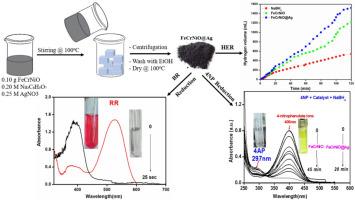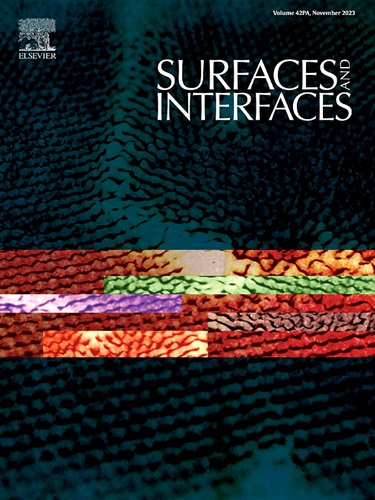Facile synthesis of Fe2.96Cr0.03Ni0.01O4@Ag core-shell nanoparticles and its efficient applications in green hydrogen generation and in removing hazardous dyes
IF 5.7
2区 材料科学
Q2 CHEMISTRY, PHYSICAL
引用次数: 0
Abstract
A unique class of materials with nanostructures known as core-shell nanoparticles (CS-NPs) has drawn more attention recently because of its intriguing characteristics and wide range of uses in drug delivery, biology, materials chemistry, photocatalysis, catalysis, sensors, and other electronic device applications. One advantage of the approach was that it was easy to use, safe, affordable, and controlled. The CS-NPs of Fe2.96Cr0.03Ni0.01O4@Ag were successfully synthesized via electrolytic cathodic deposition of FeCrNi alloy thin film on a steel substrate and then annealed at 800 °C for two hours, resulting in a FeCrNiO powder that is converted easily to FeCrNiO@Ag CS-NPs using aqueous Ag-NPs. The XRD patterns of both FeCrNiO and FeCrNiO@Ag CS-NPs show the formation of a mixture of iron oxide (Fe2O3) and magnetite oxide (Fe2.96Cr0.03Ni0.01O4) with an average grain size of 38.36 nm and 30.18 nm, respectively. The synthesized FeCrNiO@Ag CS-NPs exhibit excellent applications in catalytic efficiency during the production of hydrogen from NaBH4 hydrolysis in addition to the reduction of the nitro group of 4NP to 4AP. In another successful application, the data show that using FeCrNiO@Ag, the dyes' total reduction occurred at 0.42 min for Remazol red (RR), 1.16 min for Methyl orange (MO), 0.83 min for Congo red (CR), and 1 min for Methylene blue (MB). The kinetics investigation was conducted and proved that the reduction reactions of the dyes followed a pseudo-first-order model. This data shows that our catalytic system performs well when compared to the other catalytic systems for dye reduction, and FeCrNiO@Ag CS-NPs is a favorable material for organic dye reduction. Therefore, the CS-NPs exhibit promise efficiency towards important applications in industrial catalysis and dye reduction, as evidenced by their stability and recyclability.

Fe2.96Cr0.03Ni0.01O4@Ag核壳纳米粒子的简易合成及其在绿色制氢和有害染料脱除中的高效应用
近年来,一类具有纳米结构的独特材料——核壳纳米颗粒(CS-NPs)因其有趣的特性和在药物传递、生物学、材料化学、光催化、催化、传感器和其他电子器件应用方面的广泛应用而引起了越来越多的关注。这种方法的一个优点是易于使用、安全、负担得起和可控。通过在钢衬底上电解阴极沉积FeCrNi合金薄膜,然后在800℃下退火2小时,成功地合成了Fe2.96Cr0.03Ni0.01O4@Ag CS-NPs,得到的FeCrNiO粉末可以很容易地通过水相Ag-NPs转化为FeCrNiO@Ag CS-NPs。FeCrNiO和FeCrNiO@Ag CS-NPs的XRD谱图表明,产物为氧化铁(Fe2O3)和氧化磁铁矿(fe2.96 cr0.03 ni0.0104)的混合物,平均晶粒尺寸分别为38.36 nm和30.18 nm。合成的FeCrNiO@Ag CS-NPs在NaBH4水解制氢过程中表现出优异的催化效率,并将4NP的硝基还原为4AP。在另一个成功的应用中,数据显示,使用FeCrNiO@Ag,染料的总还原时间为:雷马唑红(RR) 0.42 min,甲基橙(MO) 1.16 min,刚果红(CR) 0.83 min,亚甲基蓝(MB) 1 min。对染料的还原反应进行了动力学研究,证明了染料的还原反应遵循伪一阶模型。这些数据表明,我们的催化体系在染料还原方面表现良好,FeCrNiO@Ag CS-NPs是有机染料还原的有利材料。因此,CS-NPs的稳定性和可回收性证明了其在工业催化和染料还原方面的重要应用前景。
本文章由计算机程序翻译,如有差异,请以英文原文为准。
求助全文
约1分钟内获得全文
求助全文
来源期刊

Surfaces and Interfaces
Chemistry-General Chemistry
CiteScore
8.50
自引率
6.50%
发文量
753
审稿时长
35 days
期刊介绍:
The aim of the journal is to provide a respectful outlet for ''sound science'' papers in all research areas on surfaces and interfaces. We define sound science papers as papers that describe new and well-executed research, but that do not necessarily provide brand new insights or are merely a description of research results.
Surfaces and Interfaces publishes research papers in all fields of surface science which may not always find the right home on first submission to our Elsevier sister journals (Applied Surface, Surface and Coatings Technology, Thin Solid Films)
 求助内容:
求助内容: 应助结果提醒方式:
应助结果提醒方式:


